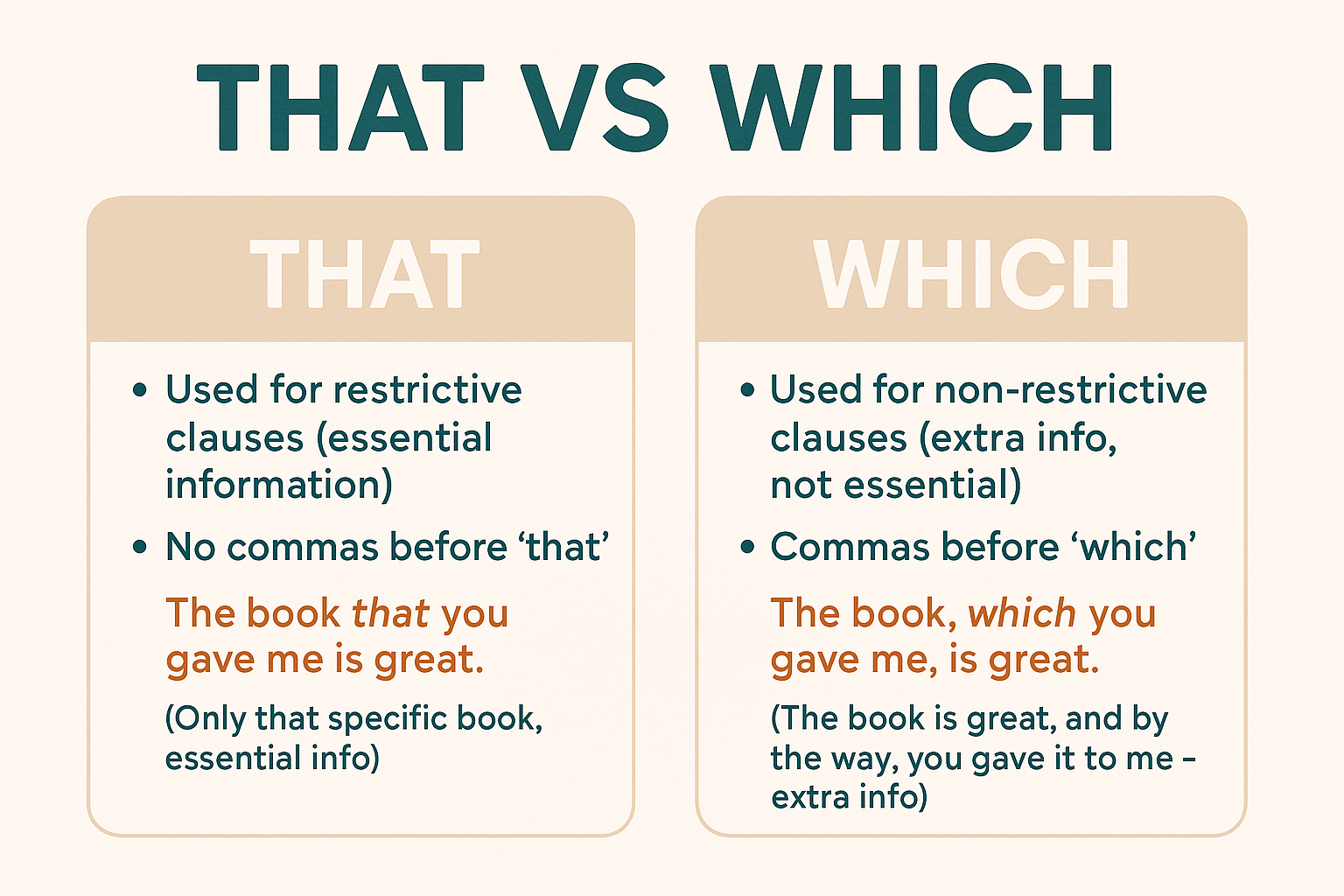That vs Which-Grammar Puzzle Solved (40)
That vs Which – Easy Rule to Avoid Sentence Confusion
Many students struggle between “that” and “which.” Both are relative pronouns, but they serve different purposes in a sentence.
You can master the rule if you understand this simple distinction: essential vs non-essential information.
What’s the Rule?
| Word | Type of Clause | Adds Info? | Punctuation? |
|---|---|---|---|
| That | Restrictive (essential) | Yes | No commas |
| Which | Non-restrictive (extra) | Yes | Use commas around it |

The Logic Behind It
- Use “that” when the clause is essential to the meaning of the sentence.
- Use “which” when the clause is non-essential (extra detail you can remove without losing meaning).
✅ Examples with “That” – Restrictive Clause (No Commas)
1. The book that has a red cover is mine.
- Can we remove the clause? No.
- “The book is mine” doesn’t tell us which book.
- The clause is essential.
- So we use that.
2. Students that submit the form early will get extra credit.
- Try removing it: “Students will get extra credit.” That’s unclear.
- The clause tells us which students, so it’s essential.
- Use that (no commas).
✅ Examples with “Which” – Non-Restrictive Clause (With Commas)
1. The book, which has a red cover, is mine.
- Can we remove the clause? Yes.
- “The book is mine.” Still makes sense.
- The red cover is just extra info.
- So we use which with commas.
2. My laptop, which I bought last year, still works great.
- Removing the clause: “My laptop still works great.” ✅ Still meaningful.
- The detail about when it was bought is not necessary.
- Use which with commas.
Compare Side-by-Side
| Sentence | Meaning | Rule |
|---|---|---|
| The car that is parked outside is mine. | Refers to a specific car. Essential info → Use that. | Restrictive |
| The car, which is parked outside, is mine. | Parking is just extra detail. → Use which. | Non-restrictive |
Quick Tip
If removing the clause changes the meaning → use “that”.
If removing it doesn’t → use “which” (with commas).
Common Mistake and Fix
❌ “The dress which she wore to the party was blue.”
✅ “The dress that she wore to the party was blue.”
Without that clause, we don’t know which dress.
So it’s essential → use that, no commas.
📝 Practice with Full Proofs
1. The emails ______ were marked urgent were answered first.
- Try removing the clause: “The emails were answered first.” ← Too general.
- Essential info → Use that
✅ “The emails that were marked urgent were answered first.”
2. Her new phone, ______ costs $1,200, has face unlock.
- Remove the clause: “Her new phone has face unlock.” ✅ Still clear.
- Non-essential info → Use which
✅ “Her new phone, which costs $1,200, has face unlock.”
Summary Table
| Use | Relative Pronoun | Commas | Example |
|---|---|---|---|
| Essential info | That | ❌ | The car that broke down was mine. |
| Extra info | Which | ✅ | The car, which I bought last year, was fast. |
Final Tip
Always test the clause:
- If it’s essential to know which one, use that.
- If it’s just extra detail, use which with commas.
English Poetry: https://englishlitnotes.com/category/english-poetry/page/7/
The Four Elements by Bradstreet:
https://americanlit.englishlitnotes.com/four-elements-by-bradstreet/
Sir Alexander Fleming by Patrick Pringle: https://englishwithnaeemullahbutt.com/2025/06/02/alexander-fleming/
Who vs whom: https://grammarpuzzlesolved.englishlitnotes.com/who-vs-whom/
For English and American literature and grammar, visit Google: https://www.google.com
Discover more from Grammar Puzzle Solved by Naeem Ullah Butt
Subscribe to get the latest posts sent to your email.